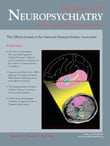Psychogenic Movement Disorder Masquerading as CJD
SIR : Creutzfeldt-Jakob Disease (CJD) is a rare, rapidly progressive prion disease characterized by dementia, dysarthria, and movement disorders, and typically culminates in death within 6 months of contraction. 1 We describe a patient who presented with a conversion disorder resembling CJD confounded by 14-3-3 proteins in his CSF.
Case Report
A 58 year-old man with a history of major depression complained of having memory impairment, difficulty walking, choppy speech, and incoordination for 1 month. There was no family history of movement disorders or dementia.
Initial examination by other physicians revealed intact immediate and recent memory and normal speech and language. He was noted to have complex choreoathetotic movements in his arms, startle myoclonus, bilateral intention tremor, and a wide-based slow gait.
Given subjective subacute memory decline, startle myoclonus and gait ataxia, the possibility of CJD was entertained. EEG and brain magnetic resonance imaging (MRI) were normal; however, 14–3–3 proteins were present in his CSF and he was diagnosed with CJD by other neurologists.
Despite complaints of new or worsening symptoms, there was no change in his examination; a repeat EEG was normal and neuropsychological testing was not consistent with a progressive dementia. His Mini-Mental State Examination (MMSE) score was 26/30 1 year after presentation and a repeat MRI was normal 18 months after presentation. Given the long duration of nonprogressive symptoms/signs and a placebo (IV normal saline) response for most of his symptoms (administered by his primary physician), he was diagnosed with conversion disorder.
Four years later, the patient remains convinced that he has CJD, and is seeking evaluation at two other academic medical centers. His symptoms continue to fluctuate and he responds to placebo for numerous complaints.
Comment
The triad of ataxia, myoclonus, and progressive memory decline in a middle-aged patient should raise suspicion for CJD. The median survival after diagnosis of CJD is 4.5 months with only 10% of patients surviving for 12 months. 1 Our patient has survived 4 years with a nonprogressive course, making the diagnosis of CJD highly unlikely. These features, in addition to placebo-responsive symptoms/signs and comorbid depression make our patient’s illness most likely psychogenic.
CJD can present with neuropsychiatric features, including depression and even hysteria. 2 Unlike the initial incorrect diagnosis of CJD in our patient, most of the literature supports the underdiagnosis of CJD in this setting. 3 EEG and MRI can be normal in patients with CJD; however, typical findings of pseudoperiodic sharp wave complexes on EEG and hyperintensity in the basal ganglia on MRI are very helpful and specific in corroborating the diagnosis. 4
While the presence of 14–3–3 protein in CSF is highly sensitive and specific for CJD in many reports, 14–3–3 proteins are found in the CSF of many patients with other neurological disorders. 5 Our patient did not exhibit clinical findings consistent with any other metabolic, inflammatory, infectious, vascular, or paraneoplastic causes for elevated 14–3–3 proteins in CSF. 5
In patients with cognitive decline, myoclonus and ataxia, the diagnosis of CJD should be considered. Disease duration longer than 1 year and lack of a rapidly progressive dementia are suggestive of another cause, even in the setting of elevated 14–3–3 proteins in the CSF.
1. Will RG, Matthews WB: A retrospective study of Creutzfeldt-Jakob disease in England and Wales 1970–79, I: clinical features. J Neurol Neurosurg Psychiatry 1984; 47:134–140Google Scholar
2. Stevens EM, Lament R: Psychiatric presentation of Jakob-Creutzfeldt disease. J Clin Psychiatry 1979; 40:445–446Google Scholar
3. Solvason HB, Harris B, Zeifert P, et al: Psychological versus biological clinical interpretation: a patient with prion disease. Am J Psychiatry 2002; 159:528–537Google Scholar
4. Cambier DM, Kantarci K, Worrell GA, et al: Lateralized and focal clinical, EEG, and FLAIR MRI abnormalities in Creutzfeldt-Jakob disease. Clin Neurophysiol 2003; 114:1724–1728Google Scholar
5. Berg D, Holzmann C, Riess O: 14-3-3 proteins in the nervous system. Nat Rev Neurosci 2003; 4:752–762Google Scholar



